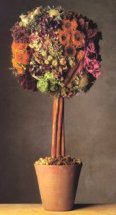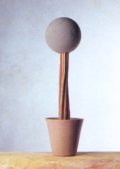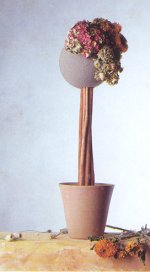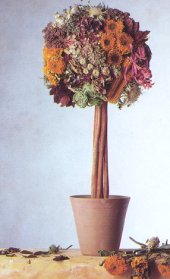| How to make a Ball Topiary
Follow the below steps and illustrations below to make a star ivy ball topiary for your outdoor garden or to highlight in your home. Substitute the live star ivy with artificial star ivy vines for an indoor topiary display. Decorate your ivy topiary to match a season or interior decor. You can make your topiary tree small or large, fill them with fresh flowers, seed heads, kitchen spices, pine foliage or dried fruit, let your imagination flow as you adapt the technique to each season and occasion. |
||
|
The topiary in the picture has an flower theme and makes an ideal gift for the kitchen or dining room.
To start, find a large sturdy terra-cotta pot or decorative planter as a base, a large dry florist’s foam ball (gray or brown), florist’s dry-hard clay and some lengths of florists stub wire to help wire some of the items so they can be inserted into the foam and held securely. Place a lump of dry-hard clay inside the terra-cotta pot, making sure that you fill the pot to approximately 2″ (5 cm) below the rim so that the base of the topiary tree is stable. You want to use clay because it will create a weighted base. Because of the height of the arrangement, it will topple over if it is not bottom heavy. |
|
|
Take some giant cinnamon sticks to form the ‘trunk’ of the topiary tree. I like to use cinnamon because they create a wonderful scent in my kitchen. Insert the sticks deep into the dry-hard clay while it is still soft and wedge them firmly. The clay will harden quickly. Then wedge a large dry foam ball onto the exposed ends of the cinnamon sticks. I advise using dry-hard clay as it does not expand and there is little risk of the terra-cotta pot cracking. | |
| Snip the stems of the sunflowers and place them directly into the foam ball so the heads are raised approximately 2″ (5 cm) above the surface of the ball. Group flower heads together so they have more of an impact when viewed from a distance. Add one large dried hydrangea head and some dried poppy seeds. If the natural stems do not hold the flower heads on the foam then you should wire the short stems in order to strengthen. If you have a glue gun, apply a small amount of glue to the wire and stems when inserting them into the foam ball. This will stop them from drooping.
Take some dried maize, wire one end with heavy gauge wire and insert. wire balls of green tagliatelle and insert (this has to done with care as the pasta may break. Group together bunches of sage, dried copper beech leaves and marjoram or oregano by binding the short stems with wire and inserting into the foam. Cut the stems of the thistles short and insert them directly into the ball. Tie some sticks of licorice into a bundle using a length of stick. Carefully wire balls of pink tagliatelle and add them to the foam. Wire and add bunches of millet. Continue to cover the surface of the foam, keeping an even all-round covering of decorative material,. Infill any gaps- no part of the ball should be visible.If you prefer you can first cover the entire ball with moss pinning it with U shaped pins, this ensures all the foam is covered. Fill the pot with pistachio nuts and star shaped dried aniseed so the dry-hard clay is concealed.” |
||
|
This a delicate topiary tree would make a wonderful gift. A cluster of cinnamon sticks has been placed in a weathered terra-cotta pot, then a ball of floral foam has been taped on top of the sticks and decorated with hypericum berries, holly leaves, gilded pine cones and roses. The general shortage of raw material in winter makes this an excellent time for using long lasting flowers , such as chrysanthemum, carnations, and Dendrobium orchids, You can also gild gold and silver seed heads and twigs which retain their shape in warm rooms as they are already dehydrated, and use ribbon and rope decoratively to make up for any lack in floral color. | |
|
||
About Philip Travers
Twitter •



 WishLists
WishLists
 My Account
My Account









